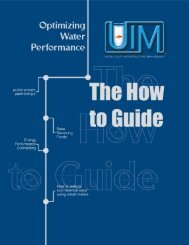Download - Water Utility Infrastructure Management
Download - Water Utility Infrastructure Management
Download - Water Utility Infrastructure Management
You also want an ePaper? Increase the reach of your titles
YUMPU automatically turns print PDFs into web optimized ePapers that Google loves.
Horizontal<br />
Directional<br />
Drilling:<br />
Enabling Innovative Approaches to<br />
<strong>Water</strong> Supply Challenges<br />
By Michael Lubrecht and Dan Ombalski<br />
The technology for extracting<br />
groundwater from subsurface<br />
resources hasn’t advanced<br />
appreciably since drillers abandoned<br />
shovels and buckets for mechanized<br />
well drilling rigs. Shovels gave<br />
way to cable tool rigs in the early 1800s<br />
and mechanical improvements incrementally<br />
led to current well-drilling<br />
technology, typically rotary drive rigs<br />
with automated casing drivers. Despite<br />
mechanic al advancements in advancing<br />
a borehole, however, the extraction<br />
technology has remained the same:<br />
drilling and casing a vertical bore that<br />
intercepts a water table. Even the venerable<br />
cable tool rig is still used for this<br />
purpose in some locales.<br />
Meanwhile, a relatively new technology,<br />
shallow horizontal directional drilling<br />
(HDD) for utility and pipeline<br />
installation, has evolved rapidly over<br />
the past three decades. Unlike the deep<br />
directional bores used in oil exploration<br />
and production, which can extend thousands<br />
of feet deep, shallow HDD is<br />
performed from just a few feet to a few<br />
hundred feet beneath the ground surface.<br />
Shallow HDD bores typically are<br />
started from the surface at an acute<br />
angle, and are guided to a subsurface or<br />
remote surface target using sophisticated<br />
electronics packages that enable the<br />
driller to navigate and steer the drill<br />
along a desired path.<br />
In the mid 1990s, this technology<br />
was adapted to install wells for the<br />
remediation of contaminated industrial<br />
sites, military bases, gas stations and<br />
other locations. The shallow depth<br />
capabilities, combined with the ability<br />
to steer a bore beneath obstacles along<br />
a predetermined path has greatly<br />
expanded the ability to access contaminated<br />
zones with appropriate treatment<br />
technologies.<br />
More recently, HDD has been applied<br />
to water resources development projects,<br />
with promising results. Vertical<br />
drilling is likely to remain a mainstay<br />
of the water industry, but HDD can be<br />
advantageous in some cases. This article<br />
explores some of the more challenging<br />
water development scenarios,<br />
and how HDD can provide a viable<br />
solution.<br />
Common to all of these water<br />
resources solutions are their utilization<br />
of HDD’s key benefits. They require<br />
only limited surface disruption — from<br />
a single, relatively small construction<br />
footprint, screens may be set tens of<br />
feet deep, while extending laterally for<br />
hundreds of feet in length, with no<br />
other effect on the surface environment.<br />
For wells that extend beneath<br />
fragile or protected ecosystems, this<br />
means that no roads must be constructed<br />
for installation or ongoing access<br />
for maintenance.<br />
Another advantage of horizontal<br />
wells is their favorable screen to riser<br />
ratio. A horizontal well only needs to<br />
penetrate the overburden above the<br />
aquifer once (twice in the case of a<br />
double-ended well). This surface penetration<br />
is offset between four and five<br />
times the target depth of the well.<br />
Once at depth however, the length of<br />
the screened interval is only limited by<br />
the rig capacity and local geology.<br />
A shallow, 50-foot deep well takes<br />
approximately 200 feet to achieve the<br />
target depth, but may be hundreds or<br />
even in excess of 1,500 feet in length.<br />
In contrast, a network of vertical wells<br />
drilled to intercept the same volume of<br />
aquifer would require multiple rig setups,<br />
multiple wellheads, and hundreds<br />
of feet of non-productive riser casing.<br />
Thin, Shallow or<br />
Perched Aquifers<br />
Many coastal or island communities,<br />
and some desert municipalities, must<br />
tap thin, shallow or vertically constrained<br />
perched aquifers for their water<br />
supply. In some locales, the best groundwater<br />
reserves are situated in thin, sinuous<br />
buried stream channels. Production<br />
of viable quantities of water from these<br />
formations can be challenging with vertical<br />
wells — drawdown at even minimal<br />
pumping rates quickly exhausts the<br />
supply adjacent to the well, with the<br />
potential for damaging the formation.<br />
Multiple wells, spaced at intervals and<br />
pumped at lower rates may provide a<br />
more continuous water supply, but are<br />
costly to install and maintain. In coastal<br />
or island communities, saltwater intrusion<br />
is a classic problem — overpumping<br />
of the “bubble” of potable water<br />
floating above a brackish or saline layer<br />
can cause irreparable damage through<br />
saltwater intrusion.<br />
In contrast, horizontal wells are ideally<br />
suited for these aquifers. A single<br />
horizontal well may be several hundred,<br />
up to a couple thousand feet<br />
long, intersecting the aquifer for most<br />
of its length and spreading the cone of<br />
depression along the full length of<br />
28 <strong>Water</strong> <strong>Utility</strong> <strong>Infrastructure</strong> <strong>Management</strong><br />
November/December 2011








